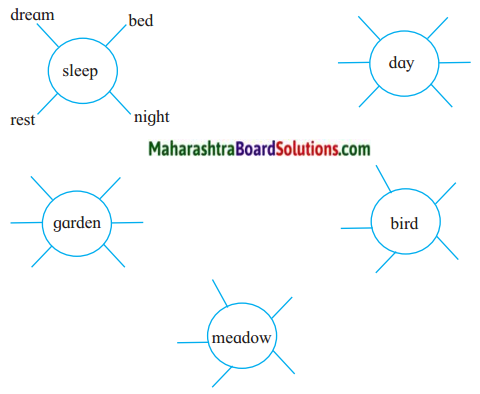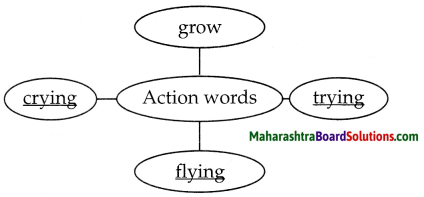Balbharti Maharashtra State Board Class 6 English Solutions Chapter 3.3 Stone Soup Notes, Textbook Exercise Important Questions and Answers.
Std 6 English Lesson 3.3 Stone Soup Question Answer Maharashtra Board
Class 6 English Chapter 3.3 Stone Soup Textbook Questions and Answers
1. Answer the following questions.
Question a.
Where does the story take place?
Answer:
The story takes place in a village.
Question b.
List the characters in the play and write one or two lines about each.
Answer:
1. Motiram – He is a farmer. He had a good produce of crops. He does not want to advertise because he is afraid he would have guests at home and he would have to share with them.
2. Sonabai – She too had a good produce. She too like Motiram did not want to advertise because she does not like to have guests.
3. Hirabai – She too feels that guests are pests. She hates to give food and money to others.
4. Rupabai – She thinks a little differently. She feels it is not right to refuse someone who comes for help.
5. Traveller – He is a traveller who has travelled a long distance and is tired and hungry. He hears the conversation of the villagers and comes to know that they are miserly. In the end he makes everyone contribute a little towards making of the soup.
![]()
Question c.
How do the following avoid giving anything to the traveller?
Answer:
Motiram – He tells the traveller that dinner was over and nothing was left. He tells the traveller to try elsewhere.
Sonabai – She pretended to be hard of hearing which eventually made the traveller try elsewhere.
Hirabai – She pretended not to understand the traveller’s language and spoke gibberish (nonsense) which made the traveller try elsewhere.
Rupabai – She told the traveller that she too was very hungry because she had not made anything as her larder was empty.
Question d.
Find what Hirabai tells the traveller by reading her words from right to left.
Answer:
Go away. No food and no rest for anyone here.
Question e.
Apart from the stone, how many things go into the soup?
Answer:
Apart from the stone, water, potatoes, carrots, tomatoes, beans, onions, ginger, salt and pepper go into making the soup.
![]()
Question f.
Does the traveller really have a magic stone?
Answer:
No, the traveller does not have a magic stone, but he uses the stone to make the miserly villagers believe that the stone was magical.
2. On any one page, note against the speech of every character, what feelings it should show to bring out the meaning best. For example, joy, fear, anger, nervousness, friendliness, dislike, surprise, wonder, excitement, politeness, rudeness, cunning, curiosity.
Question 1.
On any one page, note against the speech of every character, what feelings it should show to bring out the meaning best. For example, joy, fear, anger, nervousness, friendliness, dislike, surprise, wonder, excitement, politeness, rudeness, cunning, curiosity.
Answer:
- Rupabai – surprise, wonder
- Traveller – regret
- Rupabai – cunning
- Traveller – joy, expectation
- Rupabai – unsure
- Sonabai – friendliness
- Hirabai – apologetic
![]()
3. Read aloud / Enact the play.
Question 1.
Read aloud / Enact the play.
4. Write a recipe for the stone soup.
Question 1.
Write a recipe for the stone soup.
Answer:
The Stone Soup
Once upon a time a tired and weary traveller came to a village. The Sun had just set. The traveller was very hungry and very tired. He hoped to get food and shelter in the village. He saw cottages in a row and walked towards them when suddenly he heard voices of people chatting. He stopped to hear ….
Now can you continue with the story.
5. Form pairs. Write at least one short dialogue for each of the following expressions.
Question 1.
Form pairs. Write at least one short dialogue for each of the following expressions.
(a) I agree (b) True! (c) You are right (d) Why not? (To mean that something can be done) (e) Thank you
Answer:
For example:
(a) Amit: I think all schools should have big playgrounds.
Sumit: I agree!
(b) Mohit: It has been raining cats and dogs.
Rohit: True!
(c) Sangeeta: There is a solution to every problem.
Neeta: You are right.
(d) William: Will I be able to complete this project all by myself?
Mother: Why not?
Rohini: Here are the English notes you wanted.
Sohini: Thank you
![]()
6. Find the meaning of ‘Charity begins at home/ Find other sayings which have a similar meaning.
Question 1.
Find the meaning of ‘Charity begins at home/ Find other sayings which have a similar meaning.
Answer:
‘Charity begins at home.’ The meaning of this proverb is – A person’s first responsibility is to look after the needs of their own family and friends.
Saying with similar meanings.
- Charity and beating begins at home – John Fletcher.
- Home is where the heart is.
- Home sweet home.
- A home away from home.
Now you add some more.
7. List five questions from the play which can be answered with ‘yes’ or ‘no’.
Question 1.
List five questions from the play which can be answered with ‘yes’ or ‘no’.
Answer:
(a) Does it melt away?
(b) Have you guessed the secret of the stone soup?
(c) Do you think that is right?
(d) Can I have some food?
(e) Anyone at home?
![]()
8. Smart Answers: Form a large group. Each person asks the next one a question to get him to say ‘yes’ or ‘no’. He/She can use appropriate statements, requests or even other questions as a response. But if he/she says ‘yes’ or ‘no’, he/she is out. Otherwise he/she continues the game. Questions cannot be repeated.
Question 1.
Smart Answers: Form a large group. Each person asks the next one a question to get him to say ‘yes’ or ‘no’. He/She can use appropriate statements, requests or even other questions as a response. But if he/she says ‘yes’ or ‘no’, he/she is out. Otherwise he/she continues the game. Questions cannot be repeated.
Answer:
To be done by students.
9. Visit a library: Find stories about hosts and guests. Share them with the class. Classify the stories into funny and serious stories.
Question 1.
Visit a library: Find stories about hosts and guests. Share them with the class. Classify the stories into funny and serious stories.
Answer:
To be done by students.
Class 6 English Chapter 3.3 Stone Soup Important Questions and Answers
Reading Skills, Vocabulary and Grammar
Read the extract and answer the following questions.
Question 1.
State whether the following statements are true or false.
a. Rupabai thought differently.
b. The villagers notice the traveller when they were chatting outside Motiram’s house.
Answer:
a. True
b. False
![]()
Question 2.
What time of the day was it when the villagers were chatting?
Answer:
It was evening time when the villagers were chatting.
Question 3.
What did Hirabai think of guests?
Answer:
Hirabai thought of guests as nuisance.
Question 4.
Uninvited guests are pests according to (Choose the correct alternative)
(a) Sonabai
(b) Hirabai
(c) Motiram
(d) Rupabai
Answer:
(b) Motiram
![]()
Question 5.a.
Add a prefix to get the opposite of Polite
Answer:
Impolite
Question b.
Guests can be a nuisance. (Pick out the modal verb and add a question tag)
Answer:
Modal verb – can Guests can be a nuisance, can’t they?
Question c.
Uninvited guests are pests. (Frame a ‘Wh’ question to get the underlined word as the answer)
Answer:
What are uninvited guests?
Question d.
I never waste good food. (Identify the kind of sentence)
Answer:
Assertive/Declarative – Negative
![]()
Question e.
You are right. (Change into negative)
Answer:
You are not wrong.
Personal Response:
Question 1.
Should we help people in need? Justify.
Answer:
Yes, we should help people in need if we can. Helping others will surely give us satisfaction and we will feel happy. The person whom we help also is happy. We should remember the saying ‘What goes around comes around.’
Language Study
Do as directed.
Question 1.
Who are you, young man? (Kind of sentence)
Answer:
Interrogative sentence
![]()
Question 2.
I am not defeated. (Make it affirmative)
Answer:
I am undefeated.
Question 3.
I can hardly believe this. (Pick out the modal auxiliary)
Answer:
Modal auxiliary – can
Question 4.
I have not seen you around. (Add a question tag)
Answer:
I have not seen you around, have I?
Question 5.
I’m a poor, footsore traveller. (Pick out the adjectives)
Answer:
Adjectives – poor, footsore.
Question 6.
You can taste the goodness of fresh vegetables. (Frame a ‘wh’ question to get the underlined words as the answer)
Answer:
What can you taste?
![]()
Question 7.
It reminds me of the soup I had made some time ago. (Change the verb into past perfect)
Answer:
It had reminded me of the soup I had made some time ago.
Student’s Activity:
Question 1.
Write a simple recipe of your choice. Remember:
(a) Ingredients
(b) Method
Answer:
To be done by students.
Stone Soup Summary in English
The play ‘Stone Soup’ revolves around selfish and miserly villagers, Motiram, Sonabai, Hirabai and Rupabai and a traveller. The villagers who have their cottages closeby are discussing about people who come uninvited. They do not like to have guests, more so uninvited ones. A traveller weary and hungry enters their village and tries asking for help, but each of the villagers give some excuse not to help the travellers. In the end the traveller plays a trick on the miserly villagers, brings out a magic stone and prepares a wonderful soup, that too with things (vegetables/ items) given by the villagers themselves.
Introduction:
The play ‘Stone Soup’ is a humorous play. It is actually an old folk tale in which a hungry traveller tricks the miserly villagers into believing that soup can be made from a stone. As the pot of water boils with the stone in it, he urges the villagers, one by one, to add more and more ingredients until the soup becomes a feast fit for a king. This play tries to tell us, that when people share resources, no matter how small each contribution is, the result will always benefit all.
![]()
Glossary:
- footsore (adj) – having painful feet from much walking
- gibberish (n) – speech or writing that is meaningless
- larder (n) – a cool room in a house where food is stored
- tempting (adj) – appealing, attractive, inviting
- speechless (adj) – not knowing what to say
- generosity (n) – giving in plenty
- marvellous (adj) – extremely good or pleasing
- noble (adj) – having high moral principles
- hard of hearing (phr) – not able to hear well
- charity begins at home (proverb) – a person’s first responsibility is to look after the needs of their own family and friends
6th Std English Balbharati Textbook Solutions




